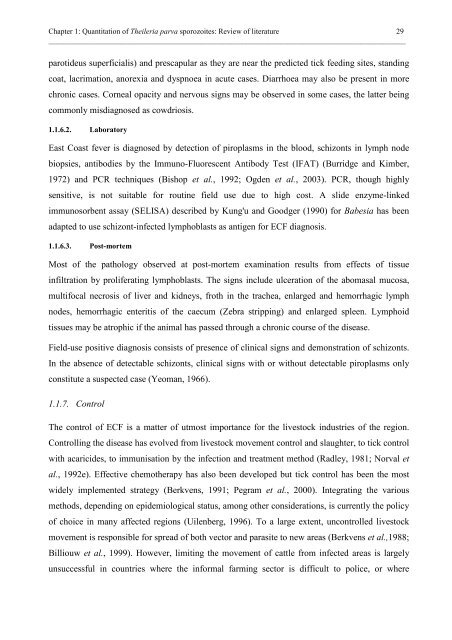In vitro quantitation of Theileria parva sporozoites for use - TropMed ...
In vitro quantitation of Theileria parva sporozoites for use - TropMed ...
In vitro quantitation of Theileria parva sporozoites for use - TropMed ...
You also want an ePaper? Increase the reach of your titles
YUMPU automatically turns print PDFs into web optimized ePapers that Google loves.
Chapter 1: Quantitation <strong>of</strong> <strong>Theileria</strong> <strong>parva</strong> <strong>sporozoites</strong>: Review <strong>of</strong> literature 29<br />
______________________________________________________________________________________________<br />
parotideus superficialis) and prescapular as they are near the predicted tick feeding sites, standing<br />
coat, lacrimation, anorexia and dyspnoea in acute cases. Diarrhoea may also be present in more<br />
chronic cases. Corneal opacity and nervous signs may be observed in some cases, the latter being<br />
commonly misdiagnosed as cowdriosis.<br />
1.1.6.2. Laboratory<br />
East Coast fever is diagnosed by detection <strong>of</strong> piroplasms in the blood, schizonts in lymph node<br />
biopsies, antibodies by the Immuno-Fluorescent Antibody Test (IFAT) (Burridge and Kimber,<br />
1972) and PCR techniques (Bishop et al., 1992; Ogden et al., 2003). PCR, though highly<br />
sensitive, is not suitable <strong>for</strong> routine field <strong>use</strong> due to high cost. A slide enzyme-linked<br />
immunosorbent assay (SELISA) described by Kung'u and Goodger (1990) <strong>for</strong> Babesia has been<br />
adapted to <strong>use</strong> schizont-infected lymphoblasts as antigen <strong>for</strong> ECF diagnosis.<br />
1.1.6.3. Post-mortem<br />
Most <strong>of</strong> the pathology observed at post-mortem examination results from effects <strong>of</strong> tissue<br />
infiltration by proliferating lymphoblasts. The signs include ulceration <strong>of</strong> the abomasal mucosa,<br />
multifocal necrosis <strong>of</strong> liver and kidneys, froth in the trachea, enlarged and hemorrhagic lymph<br />
nodes, hemorrhagic enteritis <strong>of</strong> the caecum (Zebra stripping) and enlarged spleen. Lymphoid<br />
tissues may be atrophic if the animal has passed through a chronic course <strong>of</strong> the disease.<br />
Field-<strong>use</strong> positive diagnosis consists <strong>of</strong> presence <strong>of</strong> clinical signs and demonstration <strong>of</strong> schizonts.<br />
<strong>In</strong> the absence <strong>of</strong> detectable schizonts, clinical signs with or without detectable piroplasms only<br />
constitute a suspected case (Yeoman, 1966).<br />
1.1.7. Control<br />
The control <strong>of</strong> ECF is a matter <strong>of</strong> utmost importance <strong>for</strong> the livestock industries <strong>of</strong> the region.<br />
Controlling the disease has evolved from livestock movement control and slaughter, to tick control<br />
with acaricides, to immunisation by the infection and treatment method (Radley, 1981; Norval et<br />
al., 1992e). Effective chemotherapy has also been developed but tick control has been the most<br />
widely implemented strategy (Berkvens, 1991; Pegram et al., 2000). <strong>In</strong>tegrating the various<br />
methods, depending on epidemiological status, among other considerations, is currently the policy<br />
<strong>of</strong> choice in many affected regions (Uilenberg, 1996). To a large extent, uncontrolled livestock<br />
movement is responsible <strong>for</strong> spread <strong>of</strong> both vector and parasite to new areas (Berkvens et al.,1988;<br />
Billiouw et al., 1999). However, limiting the movement <strong>of</strong> cattle from infected areas is largely<br />
unsuccessful in countries where the in<strong>for</strong>mal farming sector is difficult to police, or where











